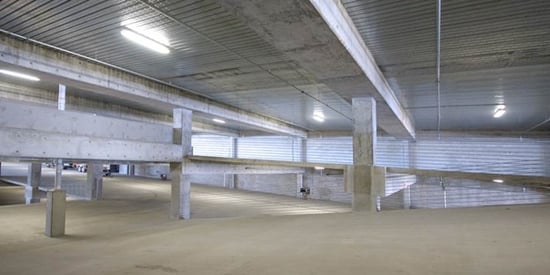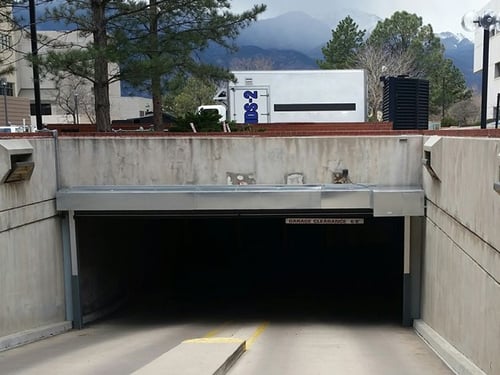 Featured Author: Jerry Cassel, MIES
Featured Author: Jerry Cassel, MIES
Parking garages pose unique lighting challenges. They must be well-lit enough to prevent accidents or crimes, but not bright enough to cause glare that can dangerously obstruct a driver’s view.
So how do you strike that perfect balance? Here’s an overview of common parking garage lighting problems that experts, like you, face, and our best advice (with some real-job examples) on how to solve them.
Parking Garage Lighting Challenge #1: Light Levels
In a parking garage, the proper amount of illumination is crucial for safety. It’s important that visitors feel comfortable driving and navigating a garage. No one wants to struggle to see while they drive, especially in an unfamiliar place full of other vehicles.
Here are some things to consider for proper light levels.
Standards
The good news is you don’t have to struggle with the proper illumination standards. The Illuminating Engineering Society publishes standards for parking garages concerning illuminance.
Determining average foot-candles for parking spaces is relatively straightforward. But one should consider entrance and exit ramps and transition zones — areas where a driver or pedestrian is coming into or out of the garage. Transitioning from a daylight environment while driving into a dark garage requires visual adaptation and time for the human eye to adjust. This ensures the safety of drivers and pedestrians. If you’ve ever driven into a tunnel, observing that entrance is well-lit and the light diminishes as you go deeper into the tunnel, the same concept should be applied to parking garages.
Codes and Ordinances
Various codes and ordinances ensure proper illumination in parking garages. Usually, a minimum of 50 foot-candles is required near those entrances, exits, and transition zones during the day. They usually have different codes for nighttime, with sensors or schedulers to dim the lights to meet local or ordinance and building codes.
Around the perimeter, codes may require daylight sensors to reduce supplemental lighting where daylight is evident.
Mounting Heights and Spacing
Mounting heights and spacing can also impact proper light levels. Some garages may have an existing array of light fixtures down the middle of the aisles with parking spaces on either side. Others mount the lights right over the parking spot and leave an open, unlit aisle way. In these cases, your job is to design so that light is evenly distributed, making the area well-lit and safe.
Our Advice for Getting the Right Light Levels
Proper illumination comes down to fundamental calculation and design based on mounting heights spacing, and design of positioning. Requirements are part of the fact-finding process, but a little insight can make all the difference.
During your initial audit and fact-finding with the customer, consider other factors:
- Color: Hue can influence how much light you need. Your mind perceives bluer light, at around 5,000 Kelvin, as brighter than warmer light. So blue lights might be ideal for a parking garage but out-of-place in certain settings, like a restaurant, where a warmer light creates a hospitable, welcoming ambiance.
- Voltage: If one specifies a fixture at 120 to 277, your audit must ensure the garage voltage is consistent. The interior may be 120-277, but the rooftop poles might be 480V. You won’t find many large parking garages that are at 480 volts, but that's usually the breakover point.
- Choosing the right specs for the parking garage is paramount.
Parking Garage Lighting Challenge #2: Mounting Lights
 Another consideration is mounting heights. A light mounted too low will shine directly in a driver’s eyes and obscure their view. One mounted too high will have to be bright enough to illuminate the ground.
Another consideration is mounting heights. A light mounted too low will shine directly in a driver’s eyes and obscure their view. One mounted too high will have to be bright enough to illuminate the ground.
Your mounting height will depend on what kind of garage you’re working with and the ceiling height. Most parking garages can have a ceiling height as low as nine feet, while some are 12 feet and higher.
You may have to factor in various mounting heights within your project garage. We once worked in one parking garage for a hospital built on a hill and the parking garage had a parking deck, but the ground level started up near the front entrance of the hospital … and went all the way down to the street level. There was a difference of about nine feet at the door to 25 feet down at the street. For that job, we adjusted the fixtures wattage based on ceiling heights of nine feet, 14 feet, 20 feet and 25 feet. The image above illustrates the complexity of various mounting heights.
Our Advice for Mounting Lights
For mounting, it’s important to consider electrical connections, and mounting configurations. Lighting fixtures in parking garages are predominantly surface mounted. So, figure out whether the wiring is hidden in embedded J-boxes, or in surface-mounted conduits hard piped between fixtures. Most garage fixtures have features to let you wire it from the back of the fixture and then mount it up against the ceiling if the wiring is in a junction box.
For connections piped through surface mounted conduit, the installer quoting labor should consider whether that existing conduit can be used or whether they're going to have to scrap and replace.
Parking Garage Lighting Challenge #3: Glare
Another concern in parking garages is glare. It can interfere with vision, which is obviously dangerous for anyone behind the wheel. And glare is usually a product of fixture design.
We once replaced legacy lights in a parking garage in New Orleans, where they were very concerned about glare for drivers on the garage decks. And the solution had to factor in a variety of vehicles: A driver in a Prius will see glare at a different height than someone in an F-150. So, we mocked up several fixtures and experimented with how they shone into a driver’s eyes depending on the vehicle they were driving. With the correct fixture, we were able to minimize glare on the ramps.
Our Advice for Combatting Glare
The proper fixtures can make all the difference for glare. Some fixtures use an indirect source with internal reflectors or a perimeter mounted source.
Litetronics produces garage fixtures with soft-focus, frosted lens which evenly distribute light, and attain the proper luminance.
 Product spotlight: LED Square Garage Light
Product spotlight: LED Square Garage LightSafety. Security. Performance. Efficiency.
The new LED Square Garage Light checks all those boxes, making it a perfect choice for your parking garage application needs.

Parking Garage Lighting Challenge #4: Ordinances and Codes
Another problem in parking garage lighting is compliance with city codes, ordinances, and international building codes. Transition zones during entry and exit, for example, must meet specific minimum lighting levels according to regulations. And ordinances also outline minimums for perimeter lighting.
Some ordinances require daylight harvesting sensors. These sensors reduce the electric light in an area when daylight is sufficient and increase light levels when darker. In a garage, this can be complex. There’s always going to be nooks and crannies that get less natural light than others. So, you’ll have to be strategic in where you place your sensors. Placing them in a naturally brighter area while neglecting darker corners of the garage might mean underlighting areas that could benefit from more light.
And wet rating becomes a critical attribute for all garage fixtures, despite being indoor structures. Moisture and humidity, especially around the perimeter or where crossing ramps exist, pose risks. Open slots between decks can expose fixtures to water damage. So, ensuring proper wet rating is an essential feature in the design of parking garage lighting fixtures, addressing potential challenges related to moisture and leaks.
Our Advice for Ordinances and Codes
We recommend incorporating wet-rated fixtures and daylight harvesting sensors strategically, after researching the codes and requirements. This proactive approach will comply with city codes and ordinances, ensuring compliance with minimum lighting standards.
Parking Garage Lighting Challenges: Solved!
Addressing the challenges in parking garage lighting isn’t a tall order. It just takes a comprehensive understanding of factors like light levels, mounting heights, glare, and compliance with codes and ordinances. Striking the right balance in garage lighting takes careful consideration of standards, codes, and ordinances, along with attention to factors like mounting heights and spacing, voltage, and color. Our recommendations will help you address these challenges proactively so you can create a well-lit, safe, and compliant environment for drivers and pedestrians.
Need more help choosing the right lighting for your project? Our Lighting Design Tool has you covered.


